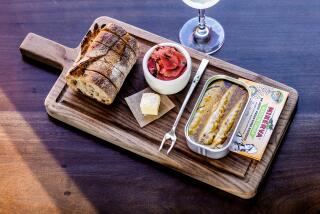Hey, Pardner, Got an Opener?
- Share via
Canning may not seem ultramodern today, but people are usually surprised to learn that it goes back to the early 19th century. Napoleon himself encouraged its development. The stomach on which his army marched was partly fed from cans.
In those days, a tinsmith would solder a sheet of tin into a cylinder shape and then solder on bottom and top lids. The top lid had a filling hole, which would be sealed after the can had been boiled to sterilize the contents. Needless to say, early canning didn’t always work perfectly. (For that matter, even as late as the early 1950s, cans sometimes swelled and even exploded because of leaks that had let the food spoil.)
The cans were opened by punching holes in them or removing a strip of metal, Spam-can fashion. Something like a modern can opener was invented in 1858.
At any rate, canning was commonplace by the days of the Old West, and a cattle outfit’s chuck wagon would have space for canned goods along with the beans, bacon, flour and cornmeal that made up the cowboy’s regular diet. There might be canned tomatoes or peaches, and there would definitely be condensed milk for making desserts and doctoring the crudely brewed “cowboy coffee.”
Why would cattlemen go to the expense of buying canned milk, not to mention the trouble of hauling it all over creation, when they were surrounded all day by thousands of head of cattle, approximately half of which were cows? Well, a range-bred longhorn cow was nothing like gentle old Bossie back on the farm. As an old-time cowboy observed 75 years ago, “He who would have attempted to milk a range cow would have dared pluck the lightning from the skies.”
More to Read
Eat your way across L.A.
Get our weekly Tasting Notes newsletter for reviews, news and more.
You may occasionally receive promotional content from the Los Angeles Times.










